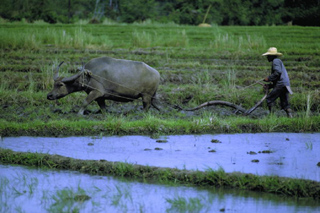
 China Tours
China Tours Tibet Tours
Tibet Tours China Theme Tours
China Theme Tours Off The Beaten Track
Off The Beaten Track Yangtze Cruises
Yangtze Cruises China Trip Planner
China Trip Planner Travel Agents
Travel Agents


We had a wonderful time in Tibet. We have learned a lot about this unique destination because of the wonderful guide Degyi who is so knowledge and always available towards our tours. We stayed at the Shangri-La Hotel Lhasa, and we would never imagine a Tibet travel could be so nice and amazing without the help of Degyi.
Also, thanks a lot to our Tibetan driver Mr.Wongdun for his safe driving and a good sense of service along the way.
We shall return Tibet in the near future!
P.B. and A. A - Europe
Tibet Travel
June 2018 (Private Tibet Journey from Kathmandu)


China is a country with a large population but less arable land. With only 7 percent of the world's cultivated land, China has to feed one fifth of the world's population. Therefore, China's agriculture is an important issue and draws wide attention of the world.
This sector has developed rapidly since reforms in the rural areas began in 1978. The major reforms were: the household contract responsibility system, which restored to the farmers the right to use land, arrange farm work, and to dispose of their output; canceling the state market monopoly of agricultural products, and of price controls over most of agricultural and ancillary products; abolishing many restrictive policies, allowing farmers to develop diversified business and set up township enterprises so as to fire their enthusiasm for production. The reforms emancipated and developed rural productive forces, promoted the rapid growth of agriculture - particularly in grain production - and the optimization of agricultural structure. The achievements have been remarkable.
In the 1990s, China's agriculture and rural economy faced unprecedented difficulties and challenges. But development momentum maintained fairly good nonetheless, with most products in surplus and supply and demand basically in balance every year. The year 2004 was a turning point, with grain production of 469.47 million tons, reversing a five-year decline. Now China leads the world in output of grain, cotton, oil plants, fruit, meat, eggs, aquatic products and vegetables.
In recent years, investment in excess of three billion yuan has been devoted to furthering agricultural industrialization, an important part of the national program for enhancing the international competitiveness of Chinese agriculture. In 2004 alone the government set up 35 agricultural programs, supported by 30 million yuan from the Central Government, over 50 million yuan from local governments, some 100 million yuan of bank loans and more than 600 million yuan raised by enterprises and farmers.
Now a pattern has been formed, with 582 key national enterprises and over 2,000 key provincial enterprises as spearhead, and agencies of various forms connecting farmers with the production base. Leading enterprises in certain sectors, e.g., corn processing, dairy industry and chicken production, have taken major market share and play an increasingly important role in the development and pricing of their respective industries.
Since 2003, the state has set up six types of demonstration projects for the industrialization of modern agro-technology, so as to promote the use of advanced technology for agricultural production, and enhance foreign earnings from exports of farm products.
These projects include industrialization of breeding and cultivation of excellent new varieties and fine strains; high-efficiency, eco-friendly planting and aquatic breeding technology; water-saving and precision technologies; downstream processing of agricultural and ancillary products; pollution-free inputs (e.g., fertilizer and fodder) and the establishment of an agricultural information platform. The "downstream processing of main agricultural products project" was listed as an important sci-tech project during the 2000-2005 Five-Year Plan period. It aims at developing key technologies and equipment for downstream processing of staple agricultural products, research into integrated quality control systems and the quick testing of agro-product technology and equipment. Once completed, some of China's technological aspects will meet the advanced international standard. Meanwhile, the "dairy industry development" and "water-saving agriculture" projects have been listed among important sci-tech application programs initiated by the Ministry of Science and Technology.
The research achievements in hybrid rice of scientist Yuan Longping, internationally regarded as the "father of hybrid rice," rewrote the history of rice cultivation in China in the second half of the 20th century. In 2003, Yuan Longping made a breakthrough in bilinear hybrid rice research. In two small demonstration fields, the per-hectare yield of super-class hybrid rice reached 12,112 kg and 12,261 kg and now large scale trials of this super-class hybrid rice are being conducted. Yuan Longping's next goal is to produce super-class hybrid rice with a yield in excess of 13,500 kg per ha before 2008.
Government programs play a significant role in improving sci-tech knowledge by conveying advanced sci-tech achievements to the countryside and to every rural household; examples include the Spark Program, the Promotion of Important Achievements Plan, the Bumper Harvest Plan, and the Prairie Fire Program.
China Trip Planner | Travel Agents | About Us | Why Us | Contact Us | How to Pay | How to Book - Terms & Conditions | Site Map
Copyright © 2010 - 2030 All Rights Reserved.


 0086-28-85711328
0086-28-85711328 0086-28-85546015
0086-28-85546015




